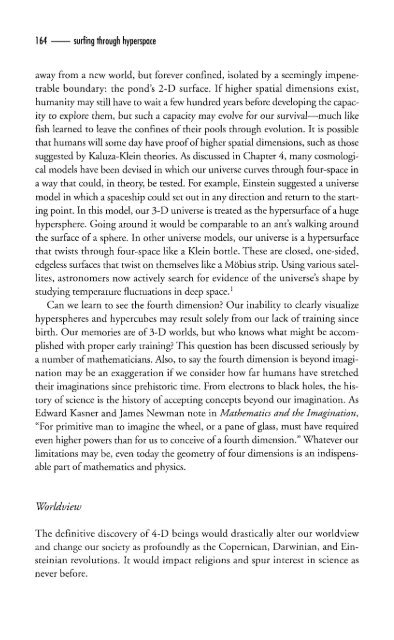clifford_a-_pickover_surfing_through_hyperspacebookfi-org
clifford_a-_pickover_surfing_through_hyperspacebookfi-org
clifford_a-_pickover_surfing_through_hyperspacebookfi-org
You also want an ePaper? Increase the reach of your titles
YUMPU automatically turns print PDFs into web optimized ePapers that Google loves.
164 <strong>surfing</strong> <strong>through</strong> hyperspoce<br />
away from a new world, but forever confined, isolated by a seemingly impenetrable<br />
boundary: the pond's 2-D surface. If higher spatial dimensions exist,<br />
humanity may still have to wait a few hundred years before developing the capacity<br />
to explore them, but such a capacity may evolve for our survival—much like<br />
fish learned to leave the confines of their pools <strong>through</strong> evolution. It is possible<br />
that humans will some day have proof of higher spatial dimensions, such as those<br />
suggested by Kaluza-Klein theories. As discussed in Chapter 4, many cosmological<br />
models have been devised in which our universe curves <strong>through</strong> four-space in<br />
a way that could, in theory, be tested. For example, Einstein suggested a universe<br />
model in which a spaceship could set out in any direction and return to the starting<br />
point. In this model, our 3-D universe is treated as the hypersurface of a huge<br />
hypersphere. Going around it would be comparable to an ant's walking around<br />
the surface of a sphere. In other universe models, our universe is a hypersurface<br />
that twists <strong>through</strong> four-space like a Klein bottle. These are closed, one-sided,<br />
edgeless surfaces that twist on themselves like a Mobius strip. Using various satellites,<br />
astronomers now actively search for evidence of the universe's shape by<br />
studying temperature fluctuations in deep space. 1<br />
Can we learn to see the fourth dimension? Our inability to clearly visualize<br />
hyperspheres and hypercubes may result solely from our lack of training since<br />
birth. Our memories are of 3-D worlds, but who knows what might be accomplished<br />
with proper early training? This question has been discussed seriously by<br />
a number of mathematicians. Also, to say the fourth dimension is beyond imagination<br />
may be an exaggeration if we consider how far humans have stretched<br />
their imaginations since prehistoric time. From electrons to black holes, the history<br />
of science is the history of accepting concepts beyond our imagination. As<br />
Edward Kasner and James Newman note in Mathematics and the Imagination,<br />
"For primitive man to imagine the wheel, or a pane of glass, must have required<br />
even higher powers than for us to conceive of a fourth dimension." Whatever our<br />
limitations may be, even today the geometry of four dimensions is an indispensable<br />
part of mathematics and physics.<br />
Worldview<br />
The definitive discovery of 4-D beings would drastically alter our worldview<br />
and change our society as profoundly as the Copernican, Darwinian, and Einsteinian<br />
revolutions. It would impact religions and spur interest in science as<br />
never before.







